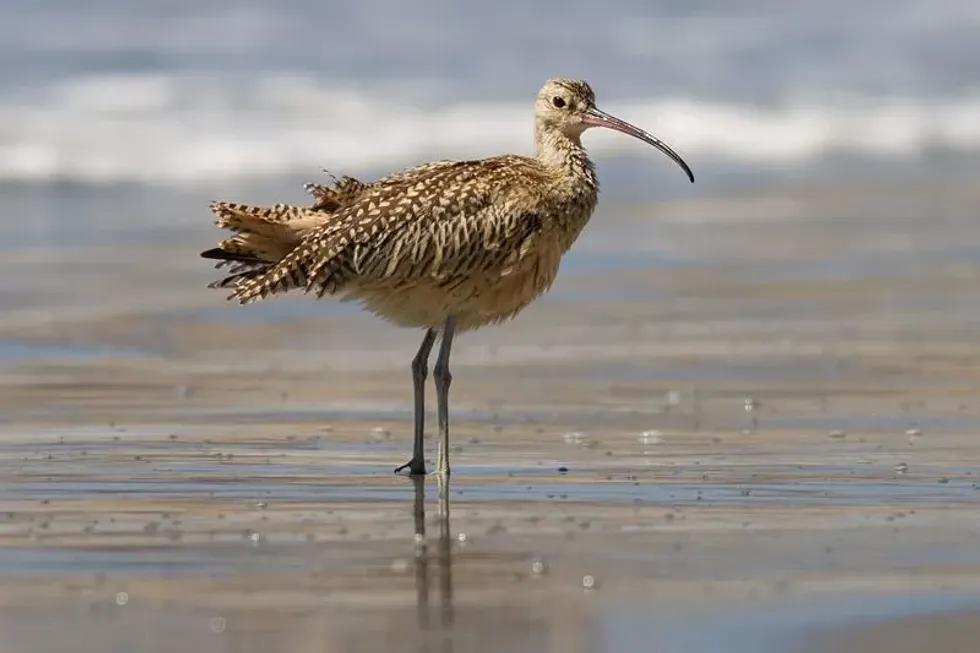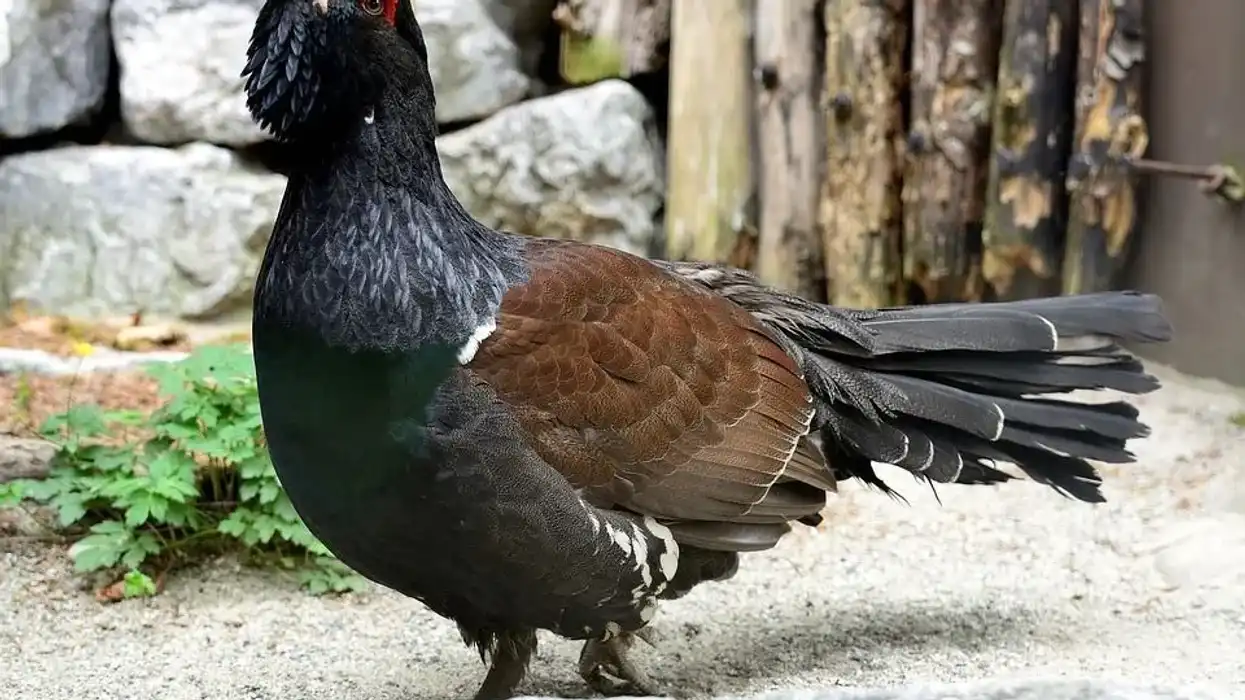An elegant bird walking on the shores of North America with an extraordinarily long curved bill and equally long legs is the famous Long-billed curlew. The Long-billed curlew (Numenius americanus) is the largest shorebird species probing in the mud areas and grasses to feed on their prey.
They belong to the order Charadriiformes, family Scolopacidae. The migratory bird is most often found on the western North American coast in large flocks with their wintering grounds further south.
The speckled brown large bird is also called a wader sometimes. The Sicklebird and the Candlestick bird are their other names.
The birds are diurnal and are territorial in nature. However, they can be heard all year-round and are believed to be vocal even during the nights. They are seen displaying spectacular undulating flight, fluttering higher and then gliding lower while giving loud ringing calls.
The bird was, interestingly, an important gaming or hunting species in the early 19th century because the much more abundant population came down drastically. Now the remaining population is protected under the US Migratory Bird Act, and hunting these birds is illegal. The birds also attract bird watchers and other tourists in their natural environment.
If you like this article, check out willet and limpkin facts too.
Long-Billed Curlew Interesting Facts
What type of animal is a Long-Billed Curlew?
The Long-billed curlew (Numenius americanus) is a North American largest shorebird. For the Long-billed curlew, the long bill is its noticeable feature. This species was also known as the Candlestick bird and the Sicklebird. And on record, there are eight species of curlews worldwide. It is the largest sandpiper.
What class of animal does a Long-Billed Curlew belong to?
The Long-billed curlew (Numenius americanus) belongs to the Aves class. They belong to the order Charadriiformes, family Scolopacidae. The genus name, Numenius, means of the new moon, which describes the slender, curved shape of the bird’s bill.
How many Long-Billed Curlews are there in the world?
The exact count of the population of these North American birds is not available. But from what is known about this bird, they are found in abundance in their natural habitat. Therefore, the IUCN Red List status of this bird is Least Concern.
Where does a Long-Billed Curlew live?
Long-billed curlews spend the summers on the coasts of western North America. The bird’s breeding grounds are in the grasslands of the Great Basin and Great Plains. Then, they migrate southward to the winter grounds. En route to the wintering grounds, they are found along the coast and interior of Mexico.
What is a Long-Billed curlew’s habitat?
Dry grasslands and shrub savannahs are the traditional Long-billed curlew habitat areas. The breeding habitat is grasslands in west-central North America.
During breeding, they also nest in grain fields, pastures, and other agricultural fields, which are now replacing the grasslands. After the young birds leave the nest to feed on their own, they may move to areas with denser and taller grasses to roost together. The wintering grounds are the flooded fields, tidal estuaries, wetlands, mudflats, and beaches.
Who do Long-Billed Curlews live with?
During migration and on the wintering grounds, Long-billed curlews forage along with other shorebirds, like Marbled godwits and Willets. A group of curlew birds is known as waders because they are seen wading in shallow waters most of their life.
A curlew spends the winter in coastal areas and sometimes thousands of them can be found in estuaries and mudflats around the UK.
How long does a Long-Billed Curlew live?
An adult Long-billed curlew exceptionally lives for up to 20 or even 30 years like the other curlews. However, a study by Redmond and Jenni (1986) contradicts this and states that a Long-billed curlew lives only up to 8-10 years in the wild.
How do they reproduce?
The Long-billed curlew reproduces by sexual reproduction. They are monogamous species.
To pair up, they indulge in a long courtship dance before mating where the male scrapes out the hollow near rocks for nesting in their breeding habitat. But the female selects the final site and builds the nest with twigs, grass, and leaves.
The female lays four eggs in the nest, and both the partners incubate the eggs for a month for them to hatch. The eggs are creamy green in color.
Long-billed curlew young are precocial, leaving the nest soon after hatching. The female birds leave the young for the male to take care of but can mate again with the same male in the next breeding season.
What is their conservation status?
According to the IUCN Red List, the conservation status of the Long-billed curlew (Numenius americanus) is near extinction. These North American birds are found in abundance in their habitat, and there is no significant threat to their population except that they are facing habitat loss.
Long-Billed Curlew Fun Facts
What do Long-Billed Curlews look like?
A Long-billed curlew is a large brown shorebird. The long bill is its distinguishing feature. These waders have long legs and wide feet to walk in the shallow water.
With a plane-streaked crown, the birds have rusted cinnamon underwings. The overall plumage has tinges of pink and orange along with streaks. Young birds have brighter colorations and smaller beaks when compared to adult birds.
How cute are they?
The birds are especially cute when they stand on one leg and tuck their neck in to rest. The exceptionally long bill and slender legs are attractive features of this bird. Their cinnamon-brown streaks feathers display pink and orange tinges on a closer look. These birds are seen in flocks foraging together.
How do they communicate?
The Long-billed curlew communicates by vocal cues as well as physical displays. The Long-billed curlew call is different during the breeding season.
These sounds are indicators of calling out to the partner and communicating their nesting territory. Generally, they can be heard all year-round, making two-note whistle-type sounds, but the birds are louder during the breeding season.
The species communicate by short quick flights in case of any danger with loud alarm calls. It spreads its wings and takes short-distance quick walks to divert the attention of any intruder, and then quickly flies off, repeating this cycle until the intruder is waded off from its territory.
How big is a Long-Billed Curlew?
Long-billed curlews are 19.6-25.5 in (50-65 cm) long. Their wingspan is 24.4-39.8 in (62-101 cm) long. They exhibit sexual dimorphism, with females being larger than males. Their long legs and comparatively longer bills are the distinguishable features of the bird.
How fast can a Long-Billed Curlew fly?
A Long-billed curlew can fly at speeds of 50 mph (80.5 kph). They are migratory species. Also, they use their flight techniques to chase away any intruders. Short and sharp flights are made during foraging and to chase the fledglings to the nest at night to roost as the young often stray away.
How much does a Long-Billed curlew weigh?
The Long-billed curlew is a large bird that weighs between 17.2-33.5 oz (490-950 g). The Long-billed curlew beak is curved, and they have a comparatively rounded body on tall legs with a long neck and small head.
What are the male and female names of the species?
No specific names are given to the male and female birds in this species. Instead, a group of curlews is called a curfew, a salon, or skein of curlews.
What would you call a baby Long-Billed Curlew?
A baby Long-billed curlew doesn’t have any specific name of its own. Young birds are precocial at birth, which means they are fully developed and are ready to leave the nest within few hours of hatching.
What do they eat?
The Long-billed curlew mainly feeds on small invertebrates, especially crabs. The bird probes the substrate on land to search and feed on. They also forage on marine crustaceans and peck on the insects like grasshoppers, beetles, caterpillars, spiders. They also feed on other birds' eggs and other birds' nestlings in their vicinity.
Are they dangerous?
Long-billed curlews are not dangerous. But the birds are highly territorial and protect their nest and fledglings. They perform threat displays by spreading their wings to ward off any intruders. However, they generally do not attack and instead fly off in case of any danger. So basically, they are not aggressive and tend to be on their own.
Would they make a good pet?
No Long-billed curlews are taken in as pets. They are shorebirds and are migratory in nature. Also, Long-billed curlews are abundantly found in their natural habitat. To take care of Long-billed curlew, their habitat should be protected and should not be tampered with.
Did you know...
Candlestick Park stadium inherited the name after this bird and Candlestick Point in San Francisco was also named after this bird.
What does it mean if you see a Long-Billed Curlew?
There are multiple beliefs related to the sighting of these birds. One major belief is that the bird is symbolic of new life and new beginnings. This, for some, maybe the end of something with a fresh start. People wish for a positive change in their lives at the sight of these birds.
Why do Curlews have long beaks?
The long beaks of the Curlews are an adaptation for their survival. The long beaks are used to probe in mud and shallow water for insects, crustaceans, and worms, their primary diet. Another adaptation of these birds is their wide feet which help them walk in the shallow waters.
You can even occupy yourself at home by coloring in one of our free printable long-billed curlew coloring pages.










